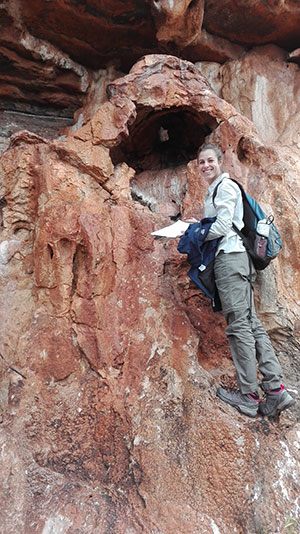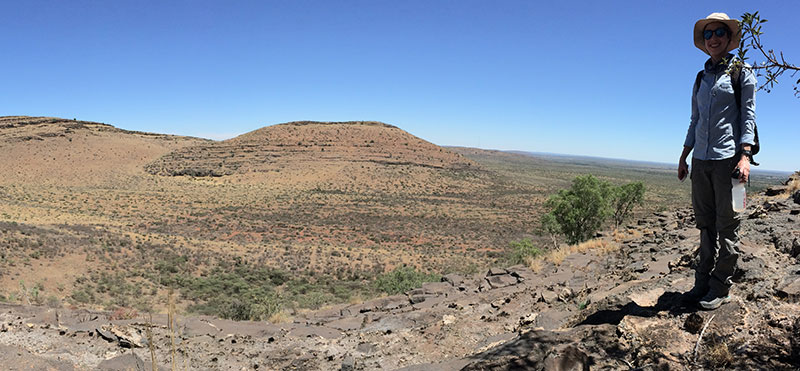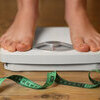Ancient secrets from the understudied Kalahari
09 April 2021 | Story Laura Rawden. Photos HERI. Read time 9 min.
Dominant theories of human evolution say our ancestors evolved behaviours seen as ‘modern’ about 100 000 years ago along the South African coast. With sites like Blombos Cave and Pinnacle Point revealing remarkable evidence of modern humans and their reliance on marine resources, the theory makes sense.
But some researchers, like archaeologist Dr Jayne Wilkins, found this a little too simplistic.

“I couldn’t stop thinking about the archaeological record of the interior,” she says. “Because so little is known about this region, I wondered if the differences between the coastal and interior records were due more to bias than reality.”
Bringing together a team of researchers that included UCT geologist Dr Robyn Pickering and local indigenous community members, Wilkins turned a nagging suspicion into a research project spanning her time as lecturer at UCT's Department of Archaeology.
The results, published in Nature on 31 March, not only flip the coastal narrative of human origins, but provide valuable insights into climate change in the Kalahari while making attempts at transforming archaeology in South Africa.
Modern human behaviour
Excavating at a rockshelter in the hillside known as Ga-Mohana in the Northern Cape, Wilkins and her team uncovered evidence of modern human behaviour including ostrich eggshell fragments and a collection of calcite crystals.
Using sophisticated dating methods, like optically stimulated luminescence, the artefacts were dated to 105 000 years ago. That’s the exact same time when similar findings were identified on the coast – except Ga-Mohana Hill is over 650 kilometres (km) from the nearest coastline.
“Our findings mean that we need to avoid overly simple models for the origins of our species. More and more it looks like many regions across the African continent were involved, and this includes the Kalahari,” says Wilkins, who is now an ARC DECRA Research Fellow at Griffith University in Australia.
Indeed, the findings point to intentional behaviour from our ancient ancestors. According to the study, the ostrich eggshells show signs of having been burned, indicating they were human collected. Ostrich eggshells have also been identified as water storage containers in other sites in southern Africa around the same time period.
The stone tools, which include a matte black stone with mineral specs nicknamed ‘Galaxy Chert’, are known to be used by early humans for spear tips, butchery and cutting up plant foods. However, the most intriguing find are the calcite crystals.
“Our findings mean that we need to avoid overly simple models for the origins of our species. More and more it looks like many regions across the African continent were involved, and this includes the Kalahari.”
"Our analysis indicates the crystals were not introduced via natural processes but were deliberately collected objects likely linked to spiritual beliefs and ritual,” says Wilkins.
Ancient pools and waterfalls
The team’s surprising findings don’t end with these ancient artefacts. Evidence of flowing waterfalls and shallow pools of standing water on what is now a dry, arid landscape was also identified.
“The hillside around the rockshelter is covered in a rock type called tufa, which would have formed as ancient water flowed along the sides and pooled above the shelter,” says Pickering, who is a co-author on the paper and a senior lecturer at the UCT Department of Geological Sciences.
Tufa slowly accumulates as water flows to forms layers, much like the rings on a tree. Using a method called uranium-thorium dating, the researchers found the layers to be between 110 and 100 000 years old, which is exactly when the people were living there.
“The record of water in the rocks not only matches the archaeological record but also provides evidence of a crucial resource for the people living at Ga-Mohana,” Pickering says.
“There is a paucity of well-dated southern hemisphere climate resources, with existing palaeoclimate records very biased towards the northern hemisphere.”
Well-dated palaeoclimate records like this are important for building modelling systems that can predict future changes in climate. But just as human origin research in this arid region is scarce, so are these records.
“There is a paucity of well-dated southern hemisphere climate resources, with existing palaeoclimate records very biased towards the northern hemisphere,” says Pickering. “To have a solid record from the southern Kalahari which we know is sensitive to changes in climate and rainfall is really valuable.”
Deeply significant site
These ancient findings aren’t surprising for those from Kuruman, a community just 12km from Ga-Mohana. “Water is deeply significant at Ga-Mohana,” says paper co-author and Kuruman local, Dr Sechaba Maape a senior lecturer at the Wits University School of Architecture and Planning.
“The indigenous worldview of the people from Kuruman is a type of animism. The water snake, which is believed to live at Ga-Mohana, is a kind of metaphor for this world view. Life, or that which is alive, is associated to water,” he says.
Maape’s expertise of the area’s traditional significance helped build a conscious and careful approach to research at the rockshelter. That included back-filling excavations between each season and leaving no trace of their work.

“Collaboration with Sechaba helped us realise how important it is that archaeology does not undermine local traditional practices because they have significant value as intangible heritage, providing connection to past communities in a country disrupted by colonialism,” says Wilkins.
That Maape is a co-author on the paper is also significant, showing a concerted effort on the part of the researchers to transform the discipline in South Africa.
“Being involved in this project, I was able to gain access to a most prestigious journal,” says Maape. “It’s a lesson to other privileged colleagues that transformation is not the responsibility of black academics more than it’s the responsibility of white academics.”
 This work is licensed under a Creative Commons Attribution-NoDerivatives 4.0 International License.
This work is licensed under a Creative Commons Attribution-NoDerivatives 4.0 International License.
Please view the republishing articles page for more information.
Research & innovation





































